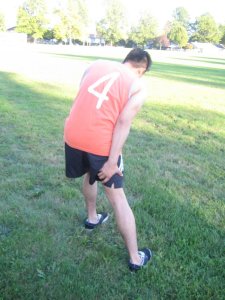The biceps femoris muscle is located at the rear part of the thigh. It is one of the three muscles which form the hamstring group of the thigh muscle. There are two other muscles such as the semitendinosus and semimembranosus. The biceps has two parts such as the pelvic bone and the femur or the thigh bone.
The function of the bicep femoris includes the extension of the hip, flexion of the knee and lateral rotation of the thigh. The biceps femoris muscle is also responsible for bending the knee when stepping into something.
Biceps femoris injury is common in some sports that require bending of the knee joint, such as sprinting. Biceps femoris tear or rupture is common among players who are fatigued or has not performed proper warmup exercises. When the biceps femoris is pulled from the bone, it will lead to an avulsion which is due to an avulsion fracture where the bone is pulled together with the tendon during excessive contraction of the muscle.
Biceps femoris injury symptoms
If an individual is suspected with an injury that affects the biceps femoris muscle, the following symptoms are likely to occur.

- The injury causes severe pain and there is difficulty in moving the legs
- The injured person finds it difficult to stand.
- The injury occurs due to sudden jumping, running where there is hip flexion and knee extension.
- The affected person can feel a sudden pop in the pulled muscle and the affected area will swell.
- The person is not capable of flexing the knee joint against resistance
- The skin becomes black and blue due to bruising.
If any of these symptoms are present, it simply indicates injury to the biceps femoris muscle.
Treatment and home remedies
- Encourage the individual to get plenty of rest as well as avoid engaging in any strenuous activities to promote the healing of the injury.
- Apply an ice pack over the affected for 15-20 minutes a few times in a day after the injury to minimize the pain and swelling.
- Use a compression wrap around the affected area or wear compression shorts since these can help minimize the swelling and bleeding.
- Elevate the legs above the level of the chest when lying down in order to improve drainage and minimize swelling. Move and stretch the injured leg gently in order to maintain mobility.
- Use a cane or crutches in order to minimize putting full weight on the affected area.
- Take over-the-counter pain medications such as ibuprofen or acetaminophen to help minimize the pain and inflammation.
- When pain and swelling subsides after a few days, the individual should engage in strengthening and range of motion exercises in order to prevent muscle atrophy and scarring.
- Massage and physiotherapy helps promote proper circulation of blood and strengthening of the muscles.
FACT CHECK
https://en.wikipedia.org/wiki/Biceps_femoris_tendon_rupture
https://www.epainassist.com/sports-injuries/thigh-pain/biceps-femoris-muscle-strain
https://physioworks.com.au/injuries-conditions-1/hamstring-strains-amp-injuries
